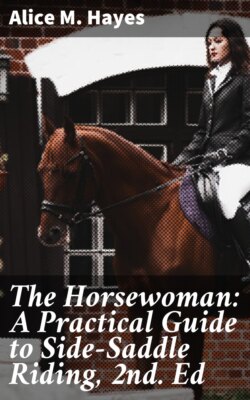Читать книгу The Horsewoman: A Practical Guide to Side-Saddle Riding, 2nd. Ed - Alice M. Hayes - Страница 17
На сайте Литреса книга снята с продажи.
GIRTHS.
ОглавлениеTable of Contents
In referring to this subject, I cannot do better than give the following extract from Riding and Hunting:—
“Girths, while fulfilling their duty of efficiently keeping the saddle on a horse’s back, should be as little liable as possible to hurt the surface on which they press. Hence they should be broad, soft, and constructed so that their tendency to retain sweat between them and the horse’s skin may be reduced as far as practicable. They can best fulfil the last-mentioned important condition when they are absorbent and open in texture. It is evident that sweat retained between the girth and the skin will have the effect of the moisture of a poultice in rendering the part soft and unusually liable to injury from pressure or friction.
“As a material for girths, wool is superior to cotton or leather, because it is softer, more absorbent, and does not become so hard on drying after having become wet. The only drawback to ordinary woollen girths is that they are not sufficiently ventilated, an objection which has been overcome in specially constructed woollen girths that are sold by many good saddlers.
“The plan of giving ventilation by slitting up a broad leather girth into several narrow straps, or by using a number of cords of cotton or of plaited or twisted raw hide often acts well; but its adoption may give rise to girth-galls, if care is not taken to smooth out, when girthing up, any wrinkles there may be in the skin underneath the girth. It is evidently more difficult for the pressure to be evenly distributed by these cords, than by a broad girth which consists of one piece.
“Great care should be taken to keep girths clean and soft, and to oil them from time to time, if they be of leather.
“I prefer a broad girth attached at each side by two buckles to two narrow girths. The Fitzwilliam girth, which consists of a broad girth with a narrow one over it, is handy with a martingale or breast-plate, through the loop of which the narrow girth can be passed.”
In a Fitzwilliam girth, the pressure of the narrow one on the centre of the broad one, makes the edges of the broad girth incline outwards, and thus apparently helps to save the horse from becoming girth-galled.
Girths should always be buckled high up on the near side, in order to prevent their buckles hurting the rider’s left leg, by making an uncomfortable bump in the flap of the saddle; and also to allow plenty of space on the girth straps of the off side, for shortening the girths as may be required.
